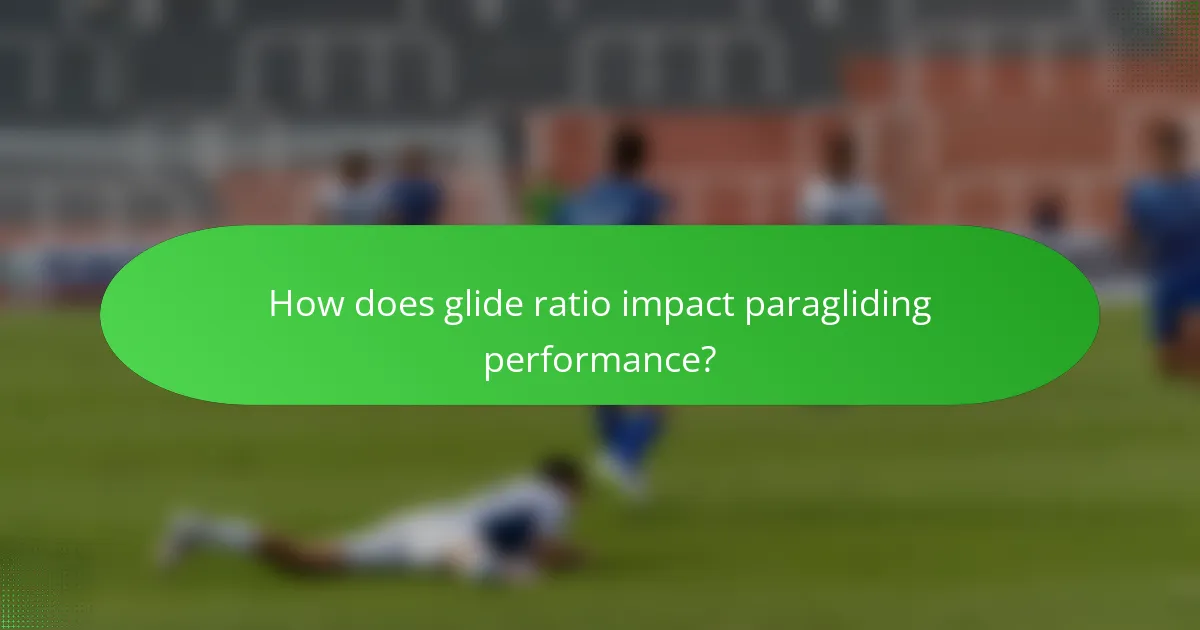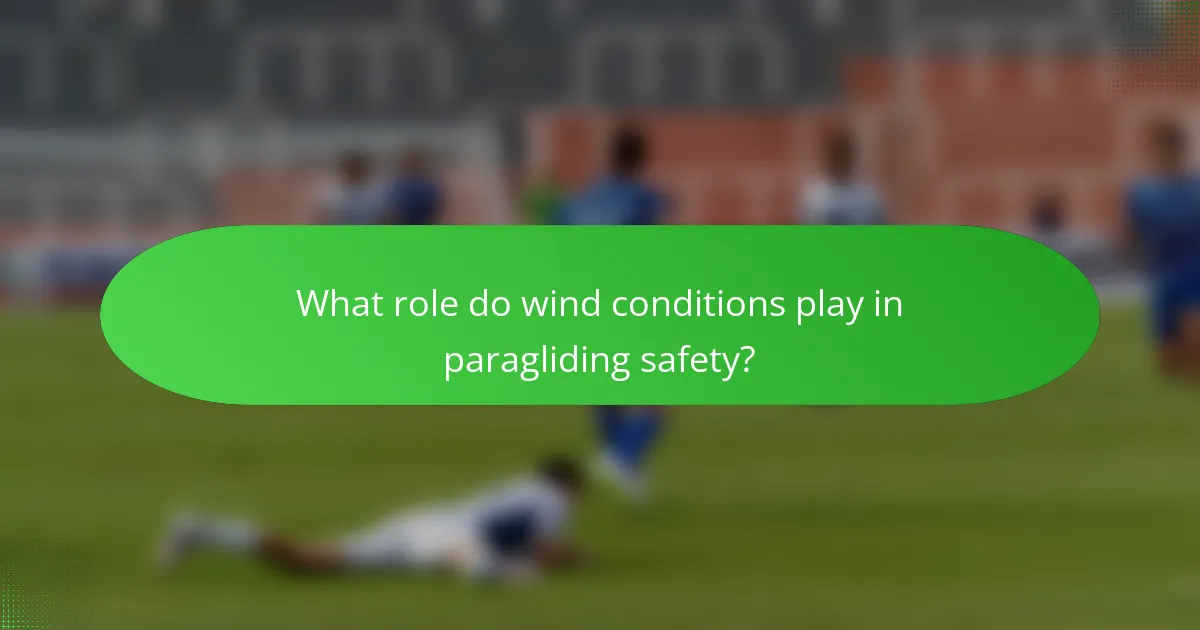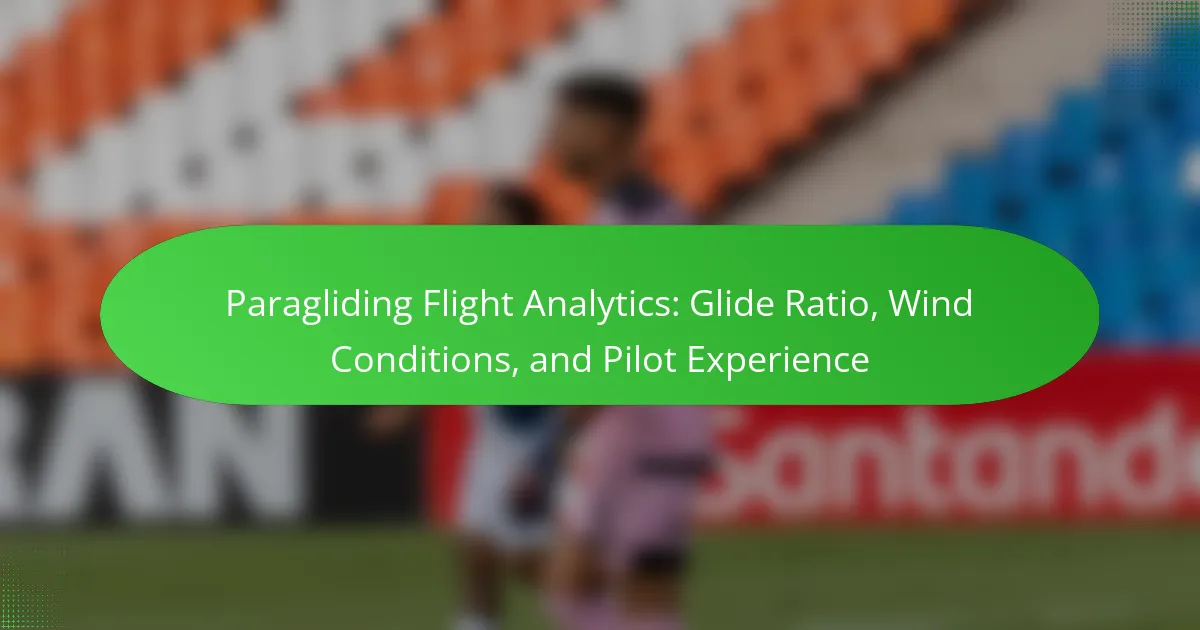Understanding paragliding flight analytics is crucial for optimising performance and ensuring safety. Key factors include glide ratio, which affects distance and descent efficiency; wind conditions, impacting stability and control; and pilot experience, enhancing decision-making. This article explores these elements and how they influence overall flight outcomes.

How does glide ratio impact paragliding performance?
Glide ratio significantly impacts paragliding performance by determining how efficiently a paraglider can travel horizontally compared to its vertical descent. A higher glide ratio indicates better performance, allowing pilots to cover greater distances with less altitude loss. For instance, a glide ratio of 10:1 means the pilot can travel 10 metres forward for every 1 metre of descent. Optimal glide ratios are influenced by various factors, including wing design, weight distribution, and environmental conditions. Understanding glide ratio helps pilots make informed decisions about flight paths and landing strategies, enhancing overall flight safety and enjoyment.
What factors influence glide ratio in paragliding?
Glide ratio in paragliding is influenced by wing design, weight distribution, wind conditions, and pilot skill. Wing design affects aerodynamic efficiency, while weight distribution impacts the centre of gravity. Wind conditions, such as headwinds or tailwinds, can either hinder or enhance glide performance. Lastly, pilot experience plays a crucial role in optimising glide techniques.
How can pilots optimise their glide ratio during flight?
Pilots can optimise their glide ratio by managing weight distribution, adjusting wing trim, and utilising wind currents effectively. Properly positioning the centre of gravity enhances stability and control during flight. Adjusting the wing’s trim settings allows for optimal lift and drag balance, which is crucial for maintaining an efficient glide. Additionally, leveraging rising air currents, such as thermals or ridge lift, can significantly improve glide performance. Understanding these factors is essential for maximising flight efficiency and extending glide distances.

What role do wind conditions play in paragliding safety?
Wind conditions significantly impact paragliding safety by affecting glide ratio, stability, and pilot control. Strong winds can lead to turbulence, increasing the risk of accidents. Pilots must analyse wind patterns and adjust their flight plans accordingly. For example, crosswinds can challenge landing approaches, while updrafts can enhance lift but may also lead to sudden altitude changes. Understanding these dynamics is essential for safe paragliding experiences.
Which wind conditions are most favourable for paragliding?
Light to moderate winds are most favourable for paragliding. Ideal wind speeds range from 5 to 15 mph, providing sufficient lift without turbulence. Crosswinds should be minimal, ideally below 5 mph, to maintain control. Thermal winds, which rise due to solar heating, enhance soaring opportunities, making them particularly advantageous for experienced pilots.
How do crosswinds affect paraglider stability and control?
Crosswinds can significantly impact paraglider stability and control by causing unpredictable movements. These winds create varying lift and drag forces, making it challenging for pilots to maintain a steady flight path. A strong crosswind can lead to increased turbulence, affecting the glide ratio and overall performance. Pilots must adjust their techniques based on wind conditions to ensure safety and effective manoeuvring. Experience plays a crucial role in managing these challenges, as skilled pilots can better anticipate and react to crosswind effects.
What are the risks of flying in turbulent wind conditions?
Flying in turbulent wind conditions poses significant risks, including loss of control and structural damage. Turbulence can lead to sudden altitude changes, making it difficult for pilots to maintain a stable glide ratio. Experienced pilots may better handle these conditions but still face dangers such as increased strain on the equipment and potential for mid-air collisions. Understanding wind dynamics and maintaining proper flight techniques are crucial for safety during paragliding.

How does pilot experience influence flight analytics?
Pilot experience significantly influences flight analytics by enhancing decision-making and optimising performance. Experienced pilots better interpret glide ratios and wind conditions, leading to improved flight outcomes. Their knowledge allows for more effective adjustments to techniques and strategies, maximising safety and efficiency during paragliding. Moreover, seasoned pilots can predict changes in weather and terrain, which directly impacts flight analytics and overall experience.
What skills are essential for novice paragliders to develop?
Novice paragliders should focus on developing skills in glide ratio assessment, understanding wind conditions, and enhancing pilot experience. Mastering glide ratio helps optimise flight performance. Recognising wind conditions is crucial for safe takeoff and landing. Accumulating flight experience builds confidence and decision-making abilities.
How do experienced pilots interpret flight data differently?
Experienced pilots interpret flight data by prioritising glide ratio and wind conditions, enhancing decision-making. They assess glide ratio to optimise flight efficiency, often utilising advanced metrics. Wind conditions are interpreted through experience, allowing pilots to adapt quickly to changing environments. This nuanced understanding differentiates them from less experienced pilots, who may rely solely on basic data.
What are the common mistakes made by inexperienced pilots?
Inexperienced pilots often make critical mistakes that can compromise safety and performance. Common errors include misjudging glide ratio, failing to assess wind conditions accurately, and underestimating the importance of experience in decision-making. These mistakes can lead to poor flight paths and increased risk during paragliding. Understanding these pitfalls is essential for improving flight skills and ensuring safety in the air.

Which tools and technologies enhance paragliding analytics?
Various tools and technologies enhance paragliding analytics, focusing on glide ratio, wind conditions, and pilot experience. GPS devices provide real-time tracking and performance metrics. Flight loggers capture detailed flight data, including altitude and speed. Weather apps offer wind forecasts and atmospheric conditions, crucial for planning flights. Data visualisation software helps analyse trends and patterns in flight performance. Mobile applications allow pilots to share experiences and insights, fostering a community-driven approach to improving skills.
What are the best flight tracking apps for paragliders?
The best flight tracking apps for paragliders include Flyskyhy, XCTrack, and Paragliding Map. These apps provide essential analytics like glide ratio, wind conditions, and pilot experience.
Flyskyhy offers real-time tracking and performance metrics, making it ideal for both beginners and seasoned pilots. XCTrack excels in providing detailed navigation features and customisable data displays. Paragliding Map integrates community-driven information, enhancing route planning and safety.
Each app has unique attributes that cater to different user needs, ensuring a comprehensive approach to paragliding analytics.
How can data analysis improve decision-making in paragliding?
Data analysis enhances decision-making in paragliding by providing insights into glide ratio, wind conditions, and pilot experience. By analysing glide ratios, pilots can optimise their flight paths for maximum efficiency. Understanding wind conditions helps in selecting safer flying times and routes. Moreover, incorporating pilot experience data allows for tailored training programmes, improving overall safety and performance. Analysing these factors collectively leads to informed decisions that enhance the flying experience.

What are the unique attributes of different paraglider models?
Different paraglider models exhibit unique attributes that influence performance and suitability for various conditions. Key distinctions include glide ratio, wing design, and weight capacity.
| Paraglider Model | Glide Ratio | Wing Design | Weight Capacity |
|——————|————-|————-|——————|
| Model A | 10:1 | Elliptical | 100 kg |
| Model B | 9:1 | Flat | 120 kg |
| Model C | 11:1 | Hybrid | 90 kg |
| Model D | 8:1 | Reflex | 110 kg |
| Model E | 10.5:1 | Elliptical | 95 kg |
| Model F | 9.5:1 | Flat | 130 kg |
These attributes shape the flying experience, impacting glide efficiency, handling in varying wind conditions, and overall pilot experience.
How do wing design and materials affect flight performance?
Wing design and materials significantly influence flight performance in paragliding. Aerodynamic shape and lightweight materials enhance glide ratio, allowing for efficient flight. For instance, wings with a higher aspect ratio reduce drag, improving speed and lift. The choice of fabric affects durability and weight, impacting overall manoeuvrability. Additionally, wing structure, such as the use of ribs and seams, contributes to stability in varying wind conditions.
Which paraglider brands are known for their analytics features?
Brands known for their analytics features in paragliding include Flymaster, Naviter, and Icaro. These brands offer advanced tools for measuring glide ratio, wind conditions, and pilot experience.
Flymaster provides comprehensive flight data analysis, enabling real-time performance tracking. Naviter’s products focus on user-friendly interfaces with detailed analytics for flight optimisation. Icaro emphasises precision in tracking flight metrics, enhancing pilot decision-making.
These brands enhance the flying experience by integrating technology that supports safety and performance. Their analytics features help pilots make informed choices based on real-time data.

What are the best practices for analysing flight data?
To analyse flight data effectively, focus on glide ratio, wind conditions, and pilot experience. These factors significantly influence performance and safety.
1. Monitor glide ratio to assess efficiency. A higher glide ratio indicates better performance, helping pilots optimise flight paths.
2. Evaluate wind conditions regularly. Understanding wind patterns aids in making informed decisions during flights, enhancing safety and control.
3. Consider pilot experience. More experienced pilots can better interpret flight data and adapt strategies, ultimately improving overall flight outcomes.
How can pilots use flight analytics to enhance their skills?
Pilots can enhance their skills using flight analytics by analysing glide ratio, wind conditions, and experience levels. These analytics provide insights into performance metrics that inform decision-making during flights.
Understanding glide ratio helps pilots optimise their flight paths for maximum efficiency. For example, a glide ratio of 10:1 indicates that for every 10 metres of horizontal distance, the pilot descends 1 metre vertically.
Monitoring wind conditions is crucial for improving flight safety and performance. Real-time data on wind speed and direction allows pilots to adjust their techniques, enhancing their ability to navigate challenging environments.
Finally, integrating personal experience data with analytics fosters continuous improvement. By reviewing past flights and correlating them with analytics, pilots can identify strengths and weaknesses, leading to more effective training and skill development.
What common metrics should pilots focus on after flights?
Pilots should focus on glide ratio, wind conditions, and pilot experience after flights. Analysing glide ratio helps assess flight efficiency, while understanding wind conditions aids in improving navigation skills. Evaluating pilot experience contributes to safety and performance enhancement.
| Metric | Description | Importance |
|——————–|——————————————–|———————————|
| Glide Ratio | Distance flown versus altitude lost | Measures flight efficiency |
| Wind Conditions | Speed and direction of wind | Affects flight stability |
| Pilot Experience | Total flight hours and skill level | Influences decision-making |
How can understanding analytics lead to safer paragliding experiences?
Understanding analytics enhances paragliding safety by optimising glide ratios, evaluating wind conditions, and assessing pilot experience. Accurate glide ratios help pilots maintain optimal flight paths, reducing the risk of accidents. Monitoring wind conditions allows for better decision-making, ensuring flights occur in safe weather. Experienced pilots leverage analytics to anticipate challenges, improving overall safety. By integrating these insights, paragliders can make informed choices, leading to safer experiences in the air.
